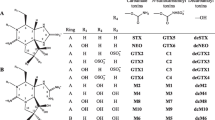Abstract
The optimal conditions were established for extraction of paralytic shellfish toxins from a Danish clone of Alexandrium tamarense using extraction with acetic acid and HCl in the concentration range 0.01–1.0 N. Physical destruction of the cells was investigated microscopically to select the most efficient extraction procedure.
The toxin content was quantitated by an automized isocratic reversed-phase high-performance liquid chromatography (HPLC) method. The best results as judged from the total amount of toxins and the toxin profile were obtained using 0.05–1.0 N acetic acid and 0.01–0.02 N HCl. Hydrochloric acid in the concentration range 0.03–1.0 N caused the amount of C1 and C2 toxins to decrease sharply and concomitant increase of gonyautoxins 2 and 3.
The phytoplankton extracts with 0.1 to 0.5 N acetic acid or 0.01 N HCl were stable during 6 months at −20 °C, but the extracts with HCl 0.02 N underwent a change in toxin profile, although the total amount of toxins was constant.
Similar content being viewed by others
References
Association of Official Analytical Chemists (AOAC) (1990) Paralytic Shellfish Poison, Biological Method, Final Action 959.08: 881–882.
Bates HA, Rapoport H (1975) A chemical assay for saxitoxin, the paralytic shellfish poison. J. agric. food Chem. 23: 237–239.
Boczar BA, Beitler MK, Liston J, Sullivan JJ, Cattolico RA (1988) Paralytic shellfish toxins in Protogonyaulax tamarensis and Protogonyaulax catenella in axenic culture. Plant Physiol. 88: 1285–1290.
Boyer GL, Sullivan JJ, Andersen RJ, Taylor FJR, Harrison PJ, Cembella AD (1986) Use of high-performance liquid chromatography to investigate the production of paralytic shellfish toxins by Protogonyaulax spp. in culture. Mar. Biol. 93: 361–369.
Flynn K, Flynn KL (in press) An automated HPLC method for rapid analysis of paralytic shellfish toxins from dinoflagellates and bacteria using precolumn oxidation at low temperature. J. exp. mar. Biol. Ecol.
Franco JM, Fernández-Vila (1993) Separation of paralytic shellfish toxins by reversed phase high performance liquid chromatography, with postcolumn reaction and fluorimetric detection. Chromatographia, 35: 613–619.
Genenah AA, Shimizu Y (1981) Specific toxicity of paralytic shellfish poisons. J. agric. food Chem. 29: 1289–1291.
Hallegraeff GM, Bolch CJ, Blackburn SI, Oshima Y (1991) Species of the toxigenic dinoflagellate genus Alexandrium in Southeastern Australian Waters. Bot. Mar. 34: 575–587.
Hansen PJ (1989) The red tide dinoflagellate Alexandrium tamarense: Effects on the growth and behaviour of a tintinnid ciliate. Mar. Ecol. Progr. Ser. 53: 105–116.
Lawrence JF, Ménard C (1991) Liquid chromatographic determination of paralytic shellfish poison in shellfish after prechromatographic oxidation. J. assoc. Off. Anal. Chem. 74; 1006–1012.
Louzao MC, Alfonso A, Botana AM, Goenaga X, Cabado AG, Vieytes MR, Botana LM (1994a) Effect of lyophilization on the stability of gonyautoxins obtained from contaminated mussels. Toxicon 32: 807–817.
Louzao MC, Alfonso A, Cabado AG, Botana AM, Goenaga X, Vieytes MR, Botana LM (1994b) Study of stability of gonyautoxins in acidic solution. Freisenius J. anal. Chem. 349: 465–468.
Nagashima Y, Noguchi T, Kawabata T, Hashimoto K (1990) Improved extraction method for paralytic shellfish poison to be used in mouse bioassay. Nippon Suisan Gakkaishi 56: 765–770.
Oshima, Y (1995) Postcolumn derivatization liquid-chromatographic method for paralytic shellfish toxins. J. assoc. Off. Anal. Chem. International, 78: 795–799.
Oshima Y, Hasegawa M, Yasumoto T, Hallegraeff G, Blackburn S (1987) Dinoflagellate Gymnodinium catenatum as the source of paralytic shellfish toxins in Tasmanian shellfish. Toxicon 25: 1105–1111.
Oshima Y, Sugino K, Yasumoto T (1989) Latest advances in HPLC analysis of paralytic shellfish toxins. In Natori S, Hashimoto K, Ueno Y. (eds), Mycotoxins and Phytotoxins '88. Elsevier, Amsterdam: 319–326.
Sullivan JJ, Iwaoka WT (1983) High pressure liquid chromatographic determination of toxins associated with paralytic shellfish poisoning. J. assoc. Off. Anal. Chem. 66: 297–302.
Sullivan JJ, Wekell MM (1987) The application of high performance liquid chromatography in a paralytic shellfish poisoning monitoring program. In Kramer DE, Liston J (eds), Seafood Quality Determination. Elsevier, New York: 357–370.
Thielert G, Kaiser I, Luckas B (1991) HPLC determination of PSP toxins. In Frémy J-M (ed.), Proceedings of Symposium on Marine Biotoxins, Edition. C.N.E.V.A., Paris: 121–125.
Van Egmond HP, van den Top HJ, Paulsch WE, Coenaga X, Vieytes MR (1994) Paralytic shellfish poison reference materials: An intercomparison of methods for the determination of saxitoxin. Food Additives and Contaminants 11: 39–56.
Author information
Authors and Affiliations
Rights and permissions
About this article
Cite this article
Ravn, H., Anthoni, U., Christophersen, C. et al. Standardized extraction method for paralytic shellfish toxins in phytoplankton. J Appl Phycol 7, 589–594 (1995). https://doi.org/10.1007/BF00003947
Received:
Revised:
Accepted:
Issue Date:
DOI: https://doi.org/10.1007/BF00003947




